What does the Bering Sea sound like? Scientists are recording the sounds of the sea, listening to determine if/how the sounds change over time.
For five years, Ricardo Antunes, a conservation scientist at the Wildlife Conservation Society in New York, has been positioning small recording devices encased in grey PVC pipe throughout northwestern Alaska seas, such as the Bering Strait and off the coast of St. Lawrence Island. Antunes says that learning what sound patterns are present in this decade will be helpful in decades to come. The Bering Sea region has been slowly warming. Its sea ice cover is shrinking. These changes have opened the coastal communities of KNOM’s listening area to increased shipping traffic.
All of these shifts may have consequences for subsistence animals, like seals and walrus, upon which many Alaska Native communities depend.
According to Antunes, the advantage of this sound survey is that the underwater recording devices can remain in place undisturbed for many months, giving scientists unbroken data of sound patterns, regardless of what’s happening at the surface. This allows them to get to know the characteristic sounds of different kinds of ocean-going mammals: “from the rubbery song of bowhead whales to walrus’ tell-tale knocks.”
Antunes explains that “marine mammals are very sensitive to noise, and additional shipping in these waters might create an impact by the introduction of noise.” Communities on St. Lawrence Island in particular, like Savoonga and Gambell, are especially concerned that more shipping could mean fewer marine mammals for subsistence.
President of the Savoonga IRA, Delbert Pungowiyi, told KNOM listeners that he grew up with 9 months of winter. But now, he says, “Every day, those of us that grew up with the ice, when we look out toward the ocean, (we’re) in a state of shock, disbelief.”
Read more of the story written by volunteer Zoe Grueskin right here at knom.org.
Image at top: Ricardo Antunes, a conservation scientist with the Wildlife Conservation Society studying sounds of the Bering Sea; photo: Ricardo Antunes, used with permission.






